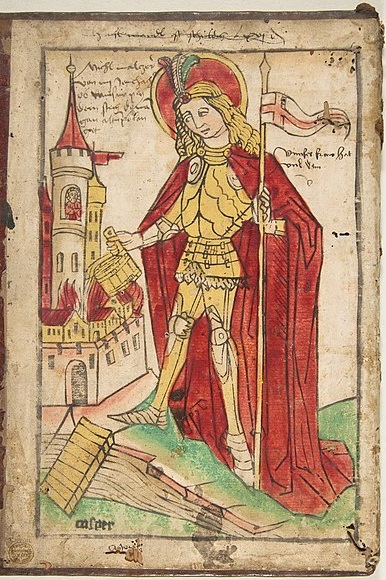Martin Johann Schmidt
St Florian extinguishing a fire, c. 1786
Oil on canvas
96.2 x 74.5 cm
Private collection
Martin Johann Schmidt, called Kremser Schmidt or Kremserschmidt, (25 September 1718 – 28 June 1801), was one of the outstanding Austrian painters of the late Baroque/Rococo along with Franz Anton Maulbertsch.
He was born at Grafenwörth, lower Austria, a son of the sculptor Johannes Schmidt. He spent most of his life at Stein, where he mostly worked in the numerous churches and monasteries of his Lower Austrian homeland. While the evolution of his style after 1750 shows that he had either spent a formative period in northern Italy or had at least had extensive contact with northern Italian works of art prior to that date, his works are also clearly influenced by Rembrandt and the great fresco-painters of the Austrian Baroque.
Despite not having received formal academic training, in 1768 he was made a member of the imperial academy at Vienna due to his artistic merits, which by that time had already been recognized by a wider public inside and outside of Austria. More on Martin Johann Schmidt
Saint Florian was born around 250 AD in the ancient Roman city of Aelium Cetium, present-day Sankt Pölten, Austria. He joined the Roman Army and advanced in the ranks, rising to commander of the imperial army in the Roman province of Noricum. In addition to his military duties, he was also responsible for organizing and leading firefighting brigades. Florian organized and trained an elite group of soldiers whose sole duty was to fight fires.
Casper
Saint Florian, circa 1460
Woodcut, hand-colored
10 x 6-9/16 in.; 11-1/4 x 7-9/16 in.
Metropolitan Museum of Art
During the Diocletianic Persecution of Christians, reports reached Rome that St. Florian was not enforcing the proscriptions against Christians in his territory. Aquilinus was sent to investigate these reports. When Aquilinus ordered Florian to offer sacrifice to the Roman gods in accordance with Roman religion, Florian refused.
Albrecht Altdorfer, (1480–1538)
Capture of St Florian, circa 1520
Oil on canvas
Height: 78.3 cm (30.8 in) ; Width: 65.2 cm (25.6 in)
Bavarian State Painting Collections
For Albrecht Altdorfer, please see below
Aquilius then offered him a raise and promotion if he would change his mind. Florian refused. Aquilius was outraged and had his soldiers beat him with whips, yet Florian stood steadfast. He told Aquilius that he had suffered many wounds for the Emperor - why not a few scratches for his own beliefs? His courage scared Aquilius who feared that Florian would lead others to rebel.
Albrecht Altdorfer (1480–1538)
Martyrdom of St Florian, circa 1516 and circa 1520
Oil on canvas
Height: 81.3 cm (32 in); Width: 66.3 cm (26.1 in)
National Gallery Prague
For Albrecht Altdorfer, please see below
Florian was sentenced to be burned at the stake. Standing on the funeral pyre, Florian is reputed to have challenged the Roman soldiers to light the fire, saying "If you wish to know that I am not afraid of your torture, light the fire, and in the name of the Lord I will climb onto it." Apprehensive of his words, the soldiers did not burn Florian, but executed him by drowning him in the Enns River with a millstone tied around his neck.
Albrecht Altdorfer
The Martyrdom of St. Florian (panel from the St. Florian altar). c.1515
Oil on wood.
Galleria degli Uffizi, Florence, Italy.
Albrecht Altdorfer (c. 1480—12 February 1538) was a German painter, engraver and architect of the Renaissance working in Regensburg, Bavaria. Along with Lucas Cranach the Elder and Wolf Huber he is regarded to be the main representative of the Danube School setting biblical and historical subjects against landscape backgrounds of expressive colours. He is remarkable as one of the first artists to take an interest in landscape as an independent subject. As an artist also making small intricate engravings he is seen to belong to the Nuremberg Little Masters. More on Albrecht Altdorfer
His body was later retrieved by Christians and buried at an Augustinian monastery near Lorch. Later a woman named Valeria had a vision in which she saw him; Florian, in this vision, declared his intent to be buried in a more appropriate location. More on Saint Florian
Please visit my other blogs: Art
Collector, Mythology, Marine
Art, Portrait of a Lady, The
Orientalist, Art of the Nude and The
Canals of Venice, Middle
East Artists, and 365 Saints, also visit my Boards on Pinterest
Images are copyright of their respective owners, assignees or others.
Some Images may be subject to copyright
I don't own any of these images - credit is always given when due unless
it is unknown to me. if I post your images without your permission, please tell
me.
I do not sell art, art prints, framed posters or reproductions. Ads are
shown only to compensate the hosting expenses.
If you enjoyed this post, please share with friends and family.
Thank you for visiting my blog and also for liking its posts and pages.
Please note that the content of this post primarily consists of articles
available from Wikipedia or other free sources online.






No comments:
Post a Comment
Note: Only a member of this blog may post a comment.